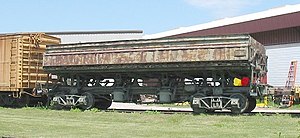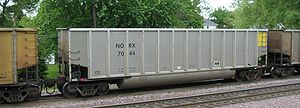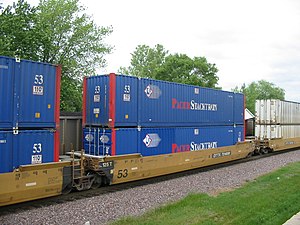Difference between revisions of "AY Honors/Model Railroad/Answer Key"
m (fix links) |
(and Luxembourg to Spain) |
||
| (3 intermediate revisions by the same user not shown) | |||
| Line 1: | Line 1: | ||
| − | + | :''For other uses, see [[Gondola (disambiguation)]]'' | |
| + | [[Image:CW 5097 at Rochelle, IL, 20040718.jpg|thumb|300px|A railroad gondola seen at [[Rochelle, Illinois]].]] | ||
| + | In [[railroad terminology]], a '''gondola''' is an open-top type of [[rolling stock]] that is used for carrying loose bulk materials. Because of its low side walls, gondolas are used to carry either very dense material, such as [[steel]] plates or coils, or bulky items such as prefabricated pieces of [[rail track]]. | ||
| − | == | + | ==History== |
| − | == | + | ==Specialized car types== |
| − | + | ===[[Coil car (rail)]]=== | |
| − | |||
| − | === | ||
| − | |||
| − | |||
| − | |||
| − | |||
| − | |||
| + | ===Lorry=== | ||
| + | An open railroad car (gondola) with a tipping trough, often found in [[mining|mines]]. | ||
| − | === | + | ===[[Track ballast]] gondolas=== |
| − | + | [[Image:Side dump gondola at NRM.jpg|thumb|A side-dump gondola on display at the [[National Railroad Museum]], [[Green Bay, Wisconsin]].]] | |
| + | {{-}} | ||
| − | + | ==="Bathtub" gondolas=== | |
| − | + | [[Image:Bathtub gondola at Rochelle.jpg|thumb|A bathtub gondola passing through [[Rochelle, Illinois]], [[May 29]], [[2005]].]] | |
| − | + | [[Image:PhosphateGon.JPG|thumb|[[CSX Transportation|CSXT]] 640006 awaits pickup at [[Edison Junction, Florida]]. Rotary gondolas such as these are used by CSXT to transport [[phosphate]] rock from the [[Bone Valley]] region to transloading facilities along [[Tampa Bay]].]] | |
| + | In the second half of the [[20th century]], [[coal]] haulage shifted from open [[hopper car]]s to high-sided gondolas. Using a gondola, the railroads are able to haul a larger amount of coal per car since gondolas do not include the equipment needed for unloading. However, since these cars do not have hatches for unloading the products shipped in them, railroads must use [[rotary car dumper]]s (mechanisms that hold a car against a short section of track as the car and track are slowly rotated upside down to empty the car) or other means to empty them. The term "bathtub" refers to the shape of the car. | ||
| + | {{-}} | ||
| − | === | + | ===Container well cars=== |
| + | [[Image:DTTX 724681 20050529 IL Rochelle.jpg|thumb|A portion of a 5-unit container car.]] | ||
| + | These specialized gondolas are designed to carry shipping [[container shipping|containers]]. A depressed center section provides a floor which is only inches above the rails. This stabilizes the container by lowering the [[center of gravity]], also allowing double-stacking, which would be impossible if the containers were placed on a [[flatcar]]. Single-unit well cars exist, but 3- and 5-car [[articulated]] sets are common. These reduce weight by reducing the number of [[bogie|trucks]] by nearly half, and also reduce the amount of slack in the train since there are fewer couplers. This protects the cargo by reducing the jolts that occur at starting and stopping caused by slack. | ||
| − | + | ===[[Modalohr]] road trailer carriers=== | |
| − | + | Specialized [[railroad car]]s carrying [[Semi-trailer|road trailers]] and [[Tractor#Other types of tractors| road tractor]]s on a route from [[France]] to [[Italy]] and [[Luxembourg]] to [[Spain]] and vice versa. A deck between the [[bogie]]s (trucks) [[pivot]]s (swings) 30°, allowing the trailers to be loaded from the sides. For details see the official sites [http://www.lohr.fr/rail-route.htm Rail-route] or [http://www.modalohr.com Modalohr] (in [[French language|French]] only). | |
| − | == | + | ==References== |
| − | + | * Double Stack Intermodal Cars-Freight [http://www.curtis-engineering.com/fdoublestackinter.htm doublestackinter] | |
| − | |||
| − | |||
| − | |||
| − | == | + | ==See also== |
| − | + | * [[Coil car (rail)]] | |
| − | + | * [[Containerization]] | |
| − | + | * [[Railgon Company]] | |
| − | |||
| − | |||
| − | |||
| − | |||
| − | |||
| − | |||
| − | |||
| − | |||
| − | |||
| − | |||
| − | |||
| − | |||
| − | |||
| − | |||
| − | |||
| − | |||
| − | |||
| − | |||
| − | |||
| − | |||
| − | |||
| − | |||
| − | |||
| − | |||
| − | |||
| − | |||
| − | |||
| − | |||
| − | |||
| − | |||
| − | |||
| − | |||
| − | |||
| − | |||
| − | |||
| − | |||
| − | |||
| − | |||
| − | |||
| − | [ | + | ==External links== |
| + | * [http://www.sdrm.org/roster/freight/gon72312/index.html Atchison, Topeka and Santa Fe Railway #72312] — photos and short history of an example of a typical steel, four-axle, solid bottom, fixed end, mill gondola. | ||
| + | |||
| + | |||
| + | {{freight cars}} | ||
| + | |||
| + | [[Category:Freight equipment]] | ||
| + | |||
| + | [[de:Offener Güterwagen]] | ||
| + | [[ja:無蓋車]] | ||
Revision as of 06:55, 30 March 2007
- For other uses, see Gondola (disambiguation)
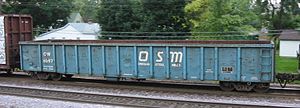
In railroad terminology, a gondola is an open-top type of rolling stock that is used for carrying loose bulk materials. Because of its low side walls, gondolas are used to carry either very dense material, such as steel plates or coils, or bulky items such as prefabricated pieces of rail track.
History
Specialized car types
Coil car (rail)
Lorry
An open railroad car (gondola) with a tipping trough, often found in mines.
Track ballast gondolas
"Bathtub" gondolas
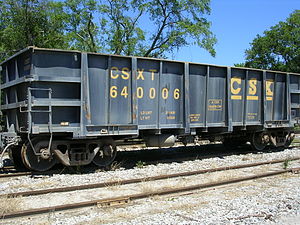
In the second half of the 20th century, coal haulage shifted from open hopper cars to high-sided gondolas. Using a gondola, the railroads are able to haul a larger amount of coal per car since gondolas do not include the equipment needed for unloading. However, since these cars do not have hatches for unloading the products shipped in them, railroads must use rotary car dumpers (mechanisms that hold a car against a short section of track as the car and track are slowly rotated upside down to empty the car) or other means to empty them. The term "bathtub" refers to the shape of the car.
Container well cars
These specialized gondolas are designed to carry shipping containers. A depressed center section provides a floor which is only inches above the rails. This stabilizes the container by lowering the center of gravity, also allowing double-stacking, which would be impossible if the containers were placed on a flatcar. Single-unit well cars exist, but 3- and 5-car articulated sets are common. These reduce weight by reducing the number of trucks by nearly half, and also reduce the amount of slack in the train since there are fewer couplers. This protects the cargo by reducing the jolts that occur at starting and stopping caused by slack.
Modalohr road trailer carriers
Specialized railroad cars carrying road trailers and road tractors on a route from France to Italy and Luxembourg to Spain and vice versa. A deck between the bogies (trucks) pivots (swings) 30°, allowing the trailers to be loaded from the sides. For details see the official sites Rail-route or Modalohr (in French only).
References
- Double Stack Intermodal Cars-Freight doublestackinter
See also
External links
- Atchison, Topeka and Santa Fe Railway #72312 — photos and short history of an example of a typical steel, four-axle, solid bottom, fixed end, mill gondola.
